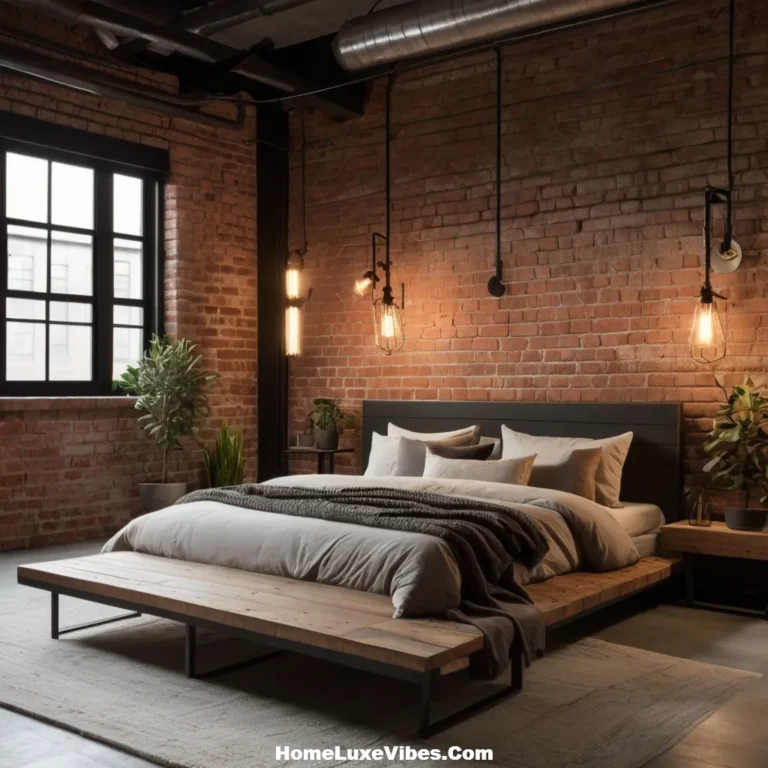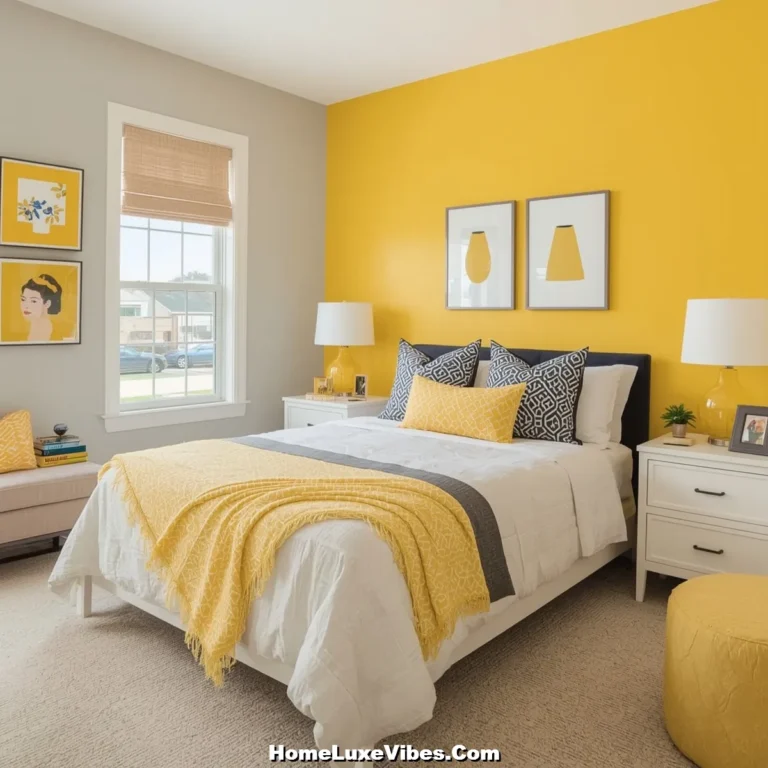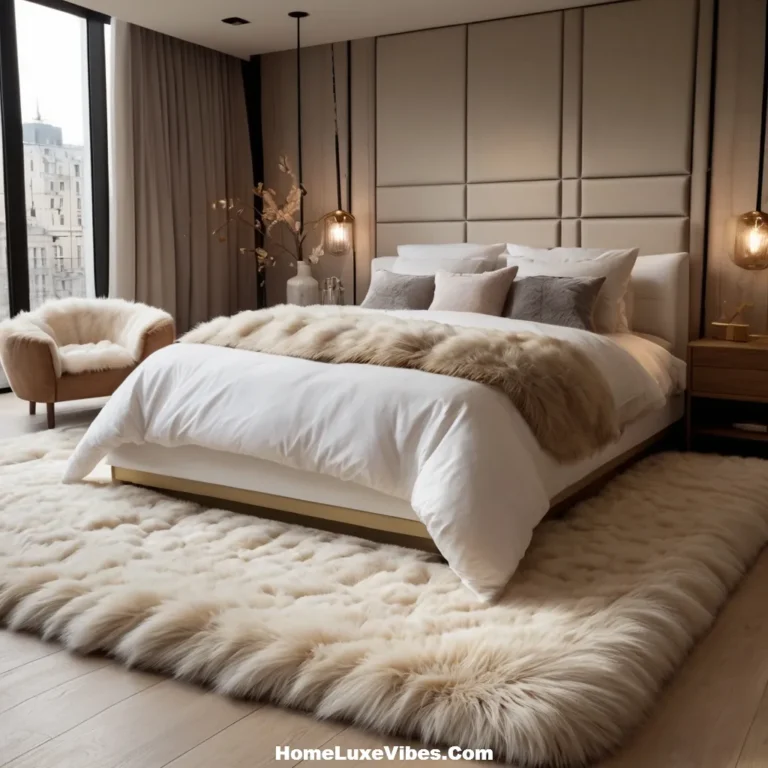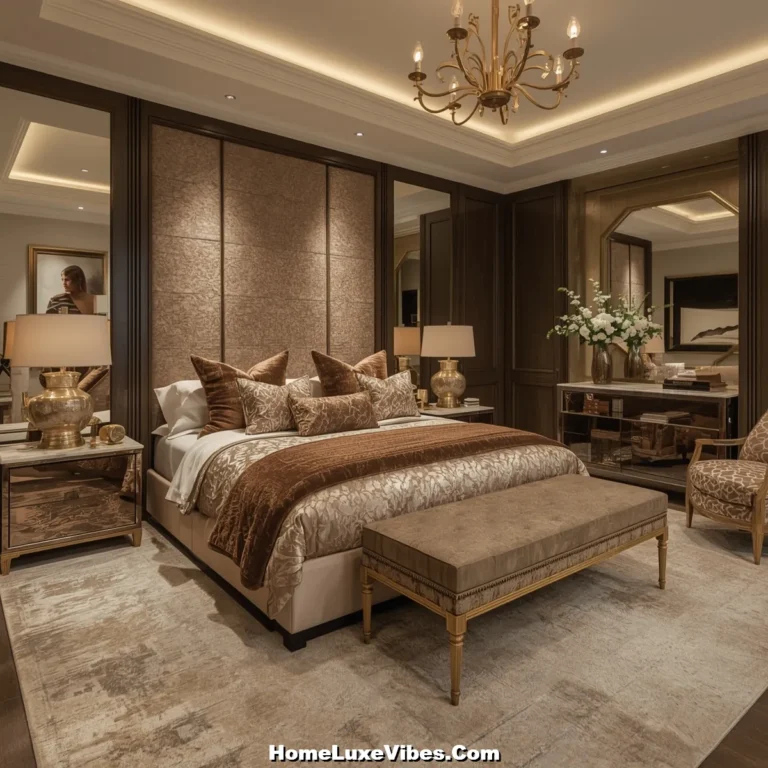13+ Aesthetic Bedroom Ideas to Transform Your Space Into a Cozy Retreat
Creating an aesthetic bedroom goes beyond simple decoration. It involves shaping a space that feels comfortable, reflects personal style, and sets the right mood. An aesthetic bedroom matters because it combines function with design, making the space both useful and visually appealing.
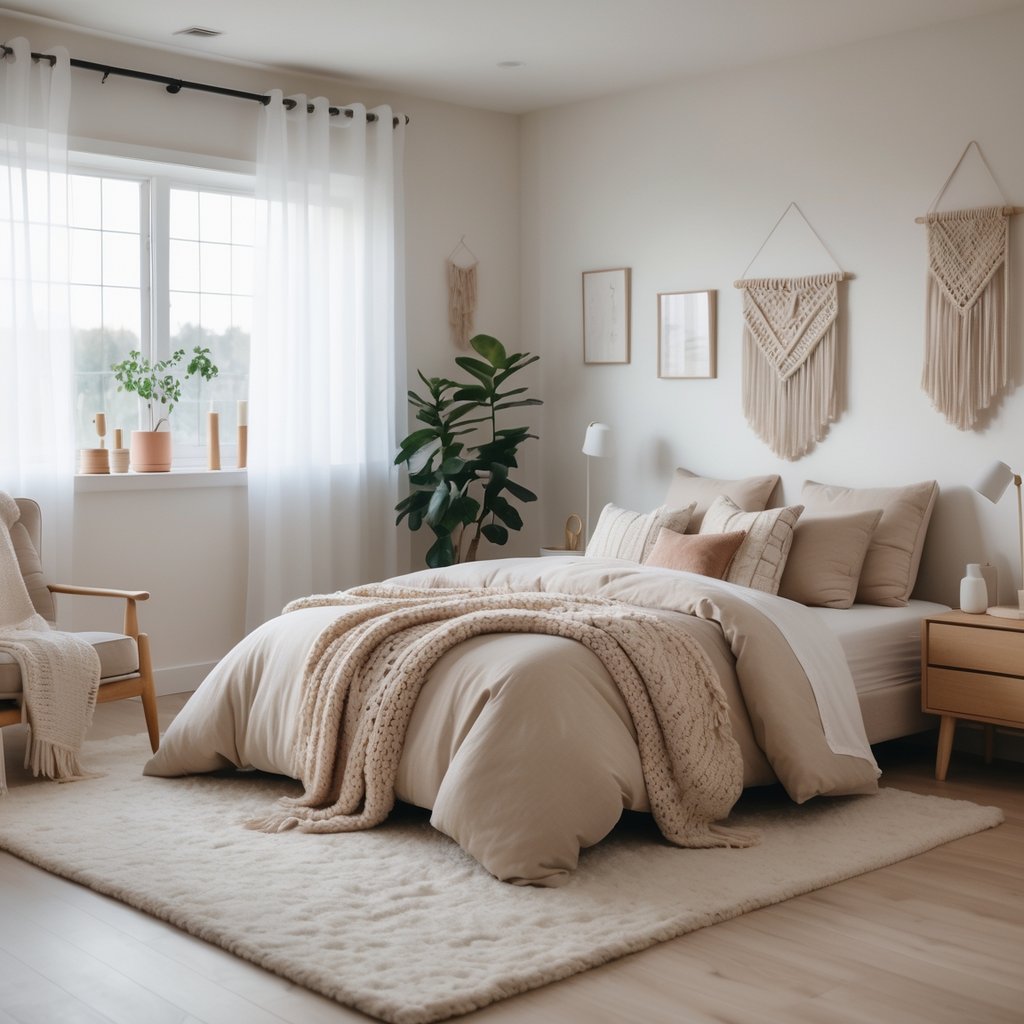
This article explores a variety of styles, from clean and simple layouts to bold and creative setups. Each idea highlights different ways to use color, texture, lighting, and decor so that anyone can shape a room that feels unique and inviting.
1. Minimalist Scandinavian Serenity:
Scandinavian design focuses on simplicity and function, making it a strong choice for a calm bedroom. Clean lines and uncluttered layouts create a space that feels open and easy to maintain. Neutral colors like white, gray, and beige keep the room light and balanced.
Natural materials play an important role in this style. Wood furniture, wool blankets, and cotton bedding add warmth without overwhelming the space. These textures keep the room cozy while staying true to the minimalist approach.
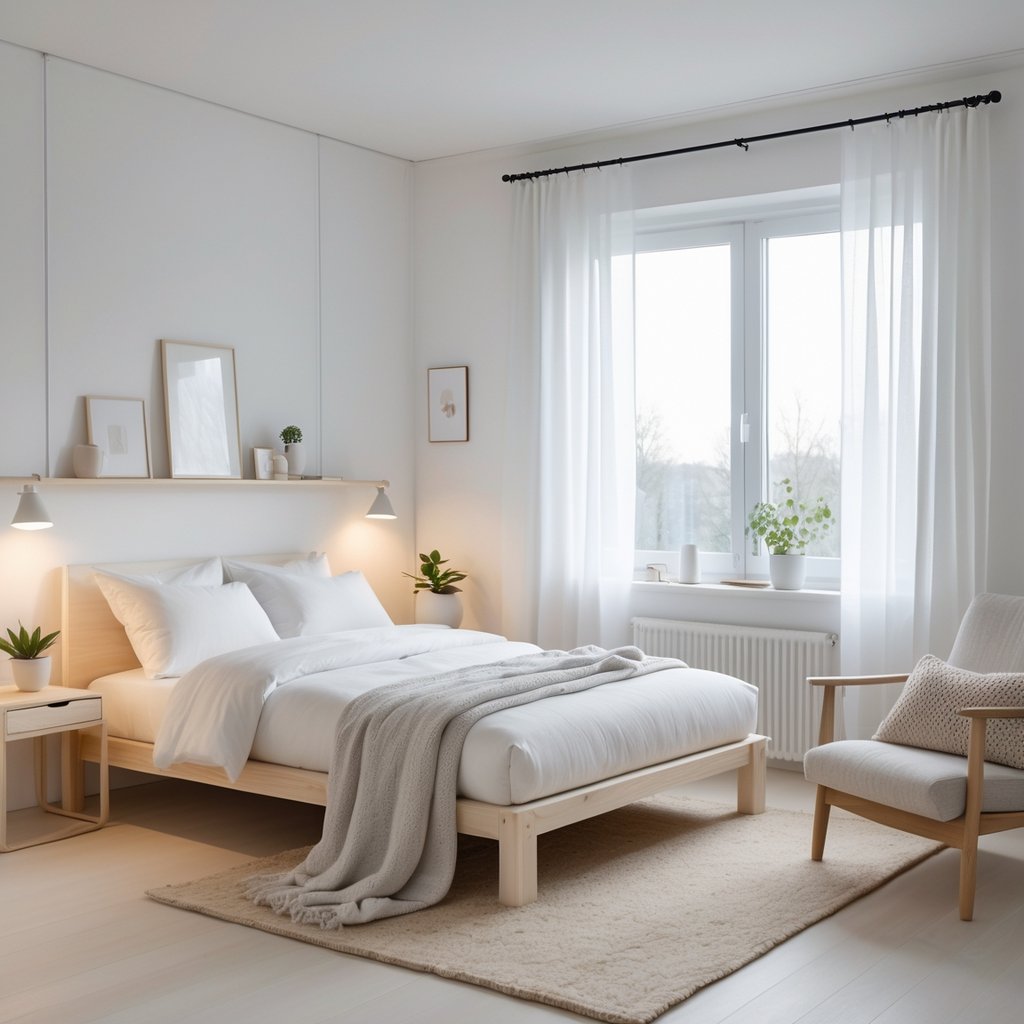
Lighting also matters in Scandinavian bedrooms. Large windows or sheer curtains allow natural light to fill the room. If natural light is limited, soft lamps and warm bulbs can provide a similar effect.
Decor is kept simple and purposeful. A few framed prints, a plant, or a textured rug can add character without creating clutter. Each detail supports a calm and functional environment.
This approach works well for anyone who values a restful space. By focusing on essentials and avoiding excess, the Scandinavian style creates a bedroom that feels both practical and inviting.
2. Bohemian Chic with Hanging Vines:
A bohemian-style bedroom often blends natural elements with relaxed design. Hanging vines fit well into this look because they bring greenery into the room without taking up floor space. They also add texture and movement to plain walls or corners.
Macramé plant hangers work well for this style because they match the handmade, eclectic feel of boho decor. Vines like pothos or philodendron are easy to care for and grow well indoors, making them practical choices.
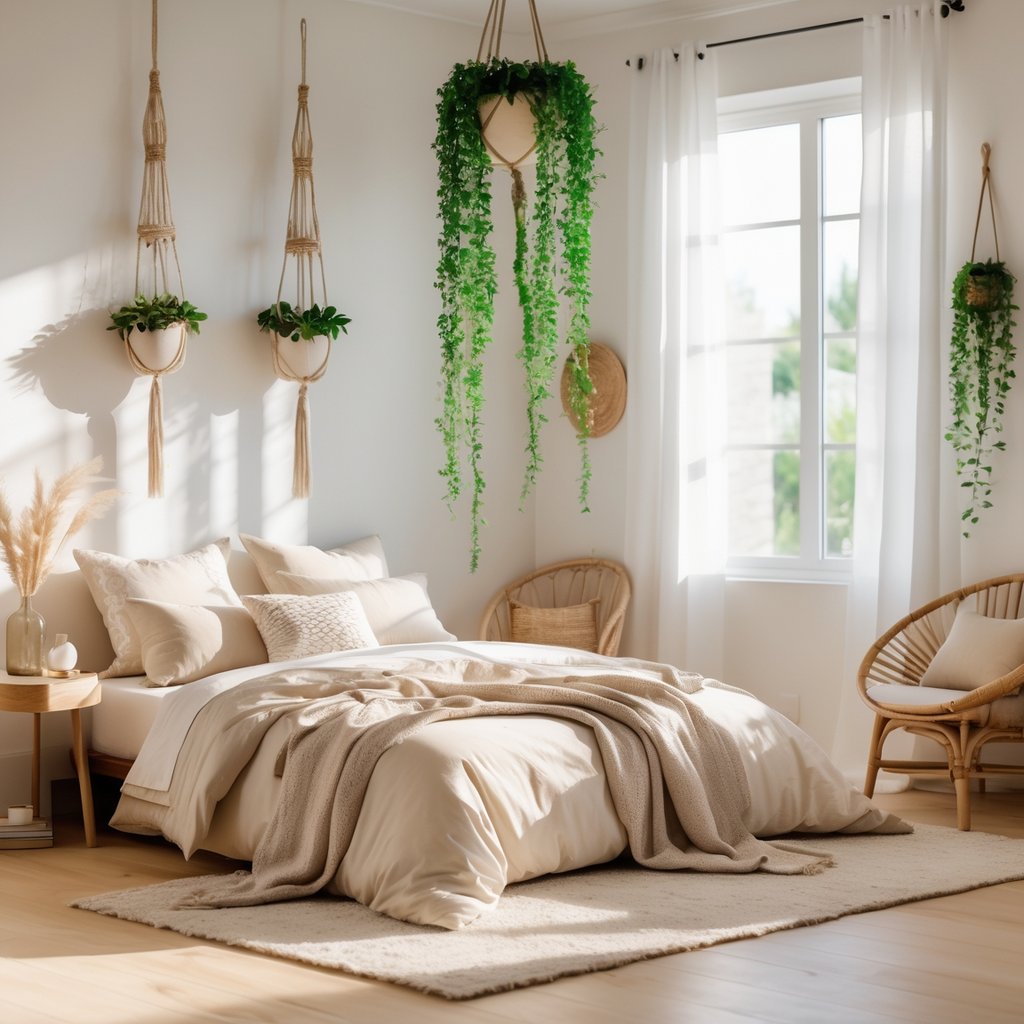
Placing vines above the bed, near windows, or along shelves can create a soft, layered effect. Some people also use vintage ladders or floating shelves to display plants at different heights. This variation helps the space feel more dynamic.
Mixing greenery with patterned textiles, woven baskets, and colorful rugs strengthens the bohemian theme. The plants add a natural balance to the bold patterns and textures often found in this style.
Hanging vines also improve the atmosphere by making the space feel more inviting. Combined with warm lighting, they create a calm setting that supports the relaxed boho look.
3. Vintage-Inspired Rustic Charm:
A vintage-inspired rustic bedroom blends natural textures with timeworn details. Wood furniture with distressed finishes, iron bed frames, and antique-style lighting create a simple yet warm atmosphere. The look feels grounded and comfortable without appearing overly polished.
Textiles play an important role in this style. Quilts, linen bedding, and woven rugs add layers of softness while keeping the design practical. Neutral tones like beige, cream, and muted gray work well, but small hints of color through pillows or throws can bring balance.
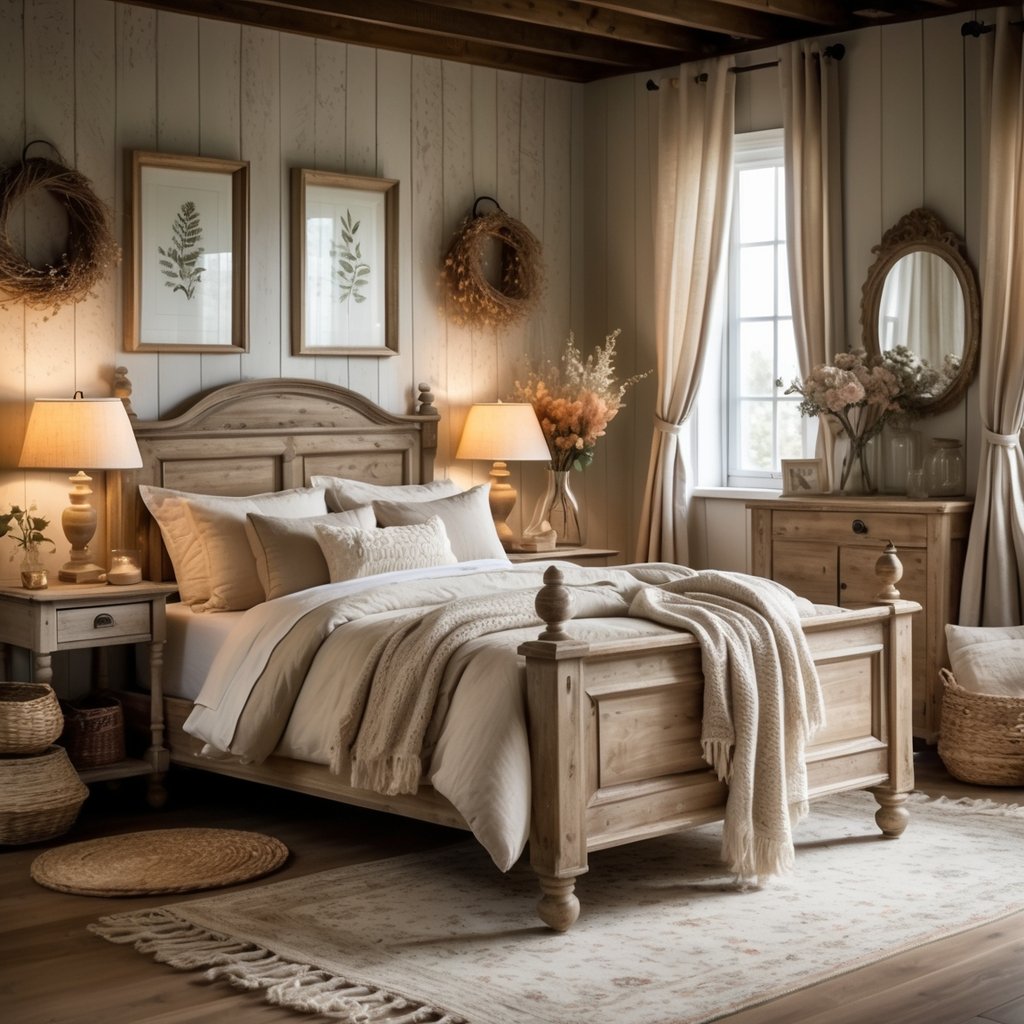
Decor pieces such as old trunks, framed black-and-white photos, or repurposed farmhouse tools can serve as accents. These items add character without overwhelming the space. Mixing vintage finds with functional modern pieces keeps the room inviting and livable.
Natural elements like wood beams, stone details, or wicker baskets can strengthen the rustic feel. When paired with vintage-inspired décor, they help create a bedroom that feels cozy, simple, and timeless.
4. Glam Hollywood Regency Luxe:
This style takes inspiration from the golden age of Hollywood, mixing bold design with a sense of luxury. It often features glossy finishes, rich fabrics, and statement pieces that make the room feel polished and intentional.
Velvet, satin, and silk are common fabric choices, adding both texture and depth. These materials pair well with metallic accents like gold, chrome, or brass, which bring a reflective quality to the space.
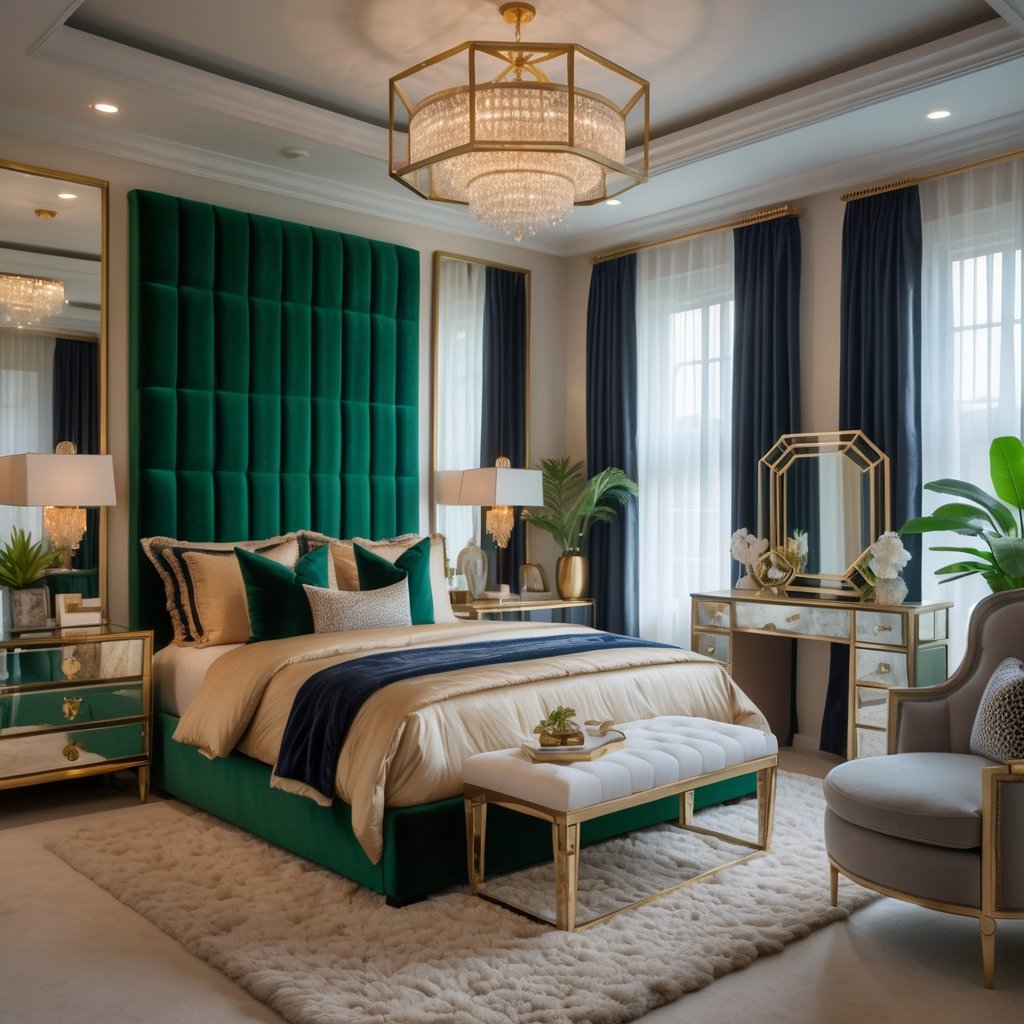
Patterns such as stripes, chevrons, or animal prints can be used to create visual interest. When balanced with solid colors, these patterns prevent the room from feeling overwhelming.
Mirrored furniture and crystal lighting add shine and brightness. A chandelier or reflective side tables can make the space feel more open while reinforcing the glamorous look.
Bold colors like emerald, navy, or deep plum often ground the design. Lighter tones, such as ivory or blush, can soften the palette and keep the room from feeling heavy.
Large statement mirrors or artwork complete the style. These pieces not only serve as focal points but also highlight the room’s balance of sophistication and comfort.
5. Modern Boho With Fairy Lights:
A modern boho bedroom blends clean lines with relaxed, eclectic details. The look often pairs simple furniture with natural textures, soft fabrics, and layered decor. Adding fairy lights introduces a warm glow that enhances the inviting atmosphere.
Fairy lights can be draped over a canopy, hung along the wall, or arranged above the bed. Their soft illumination works well with neutral tones, woven materials, and patterned textiles often used in boho design.
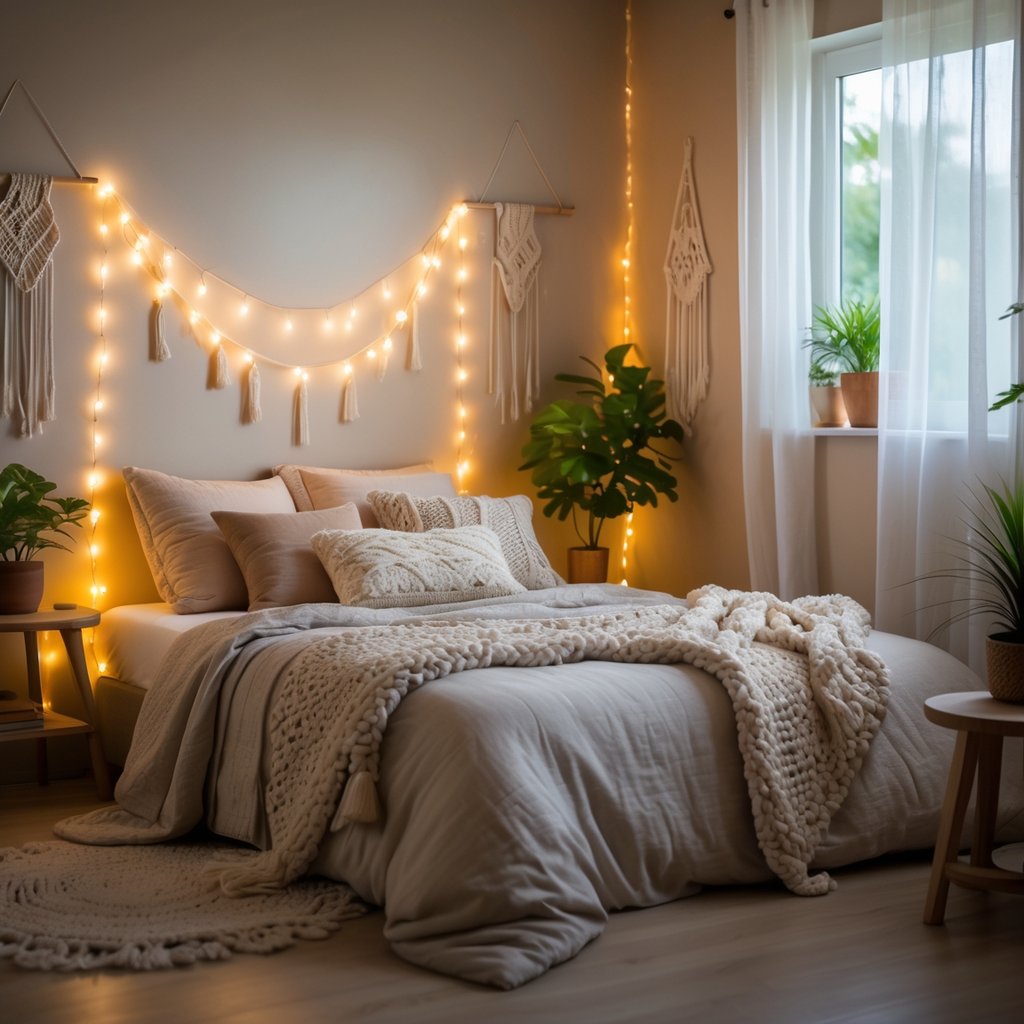
Shiny accents, such as metallic frames or reflective decor, balance the casual feel with a modern touch. This mix of sleek and cozy elements creates a space that feels both stylish and comfortable.
The combination of fairy lights and boho style encourages flexibility. The lights can highlight wall art, frame a mirror, or simply provide gentle evening lighting. This makes the design easy to adjust without major changes.
6. Coastal Beach House Vibes:
A coastal-inspired bedroom uses light colors, natural textures, and simple decor to create a calm space. Soft shades of white, beige, and blue often set the tone, echoing sand and sea.
Furniture made from weathered wood, rattan, or wicker adds warmth and texture. These natural elements help the room feel relaxed and easy to maintain.
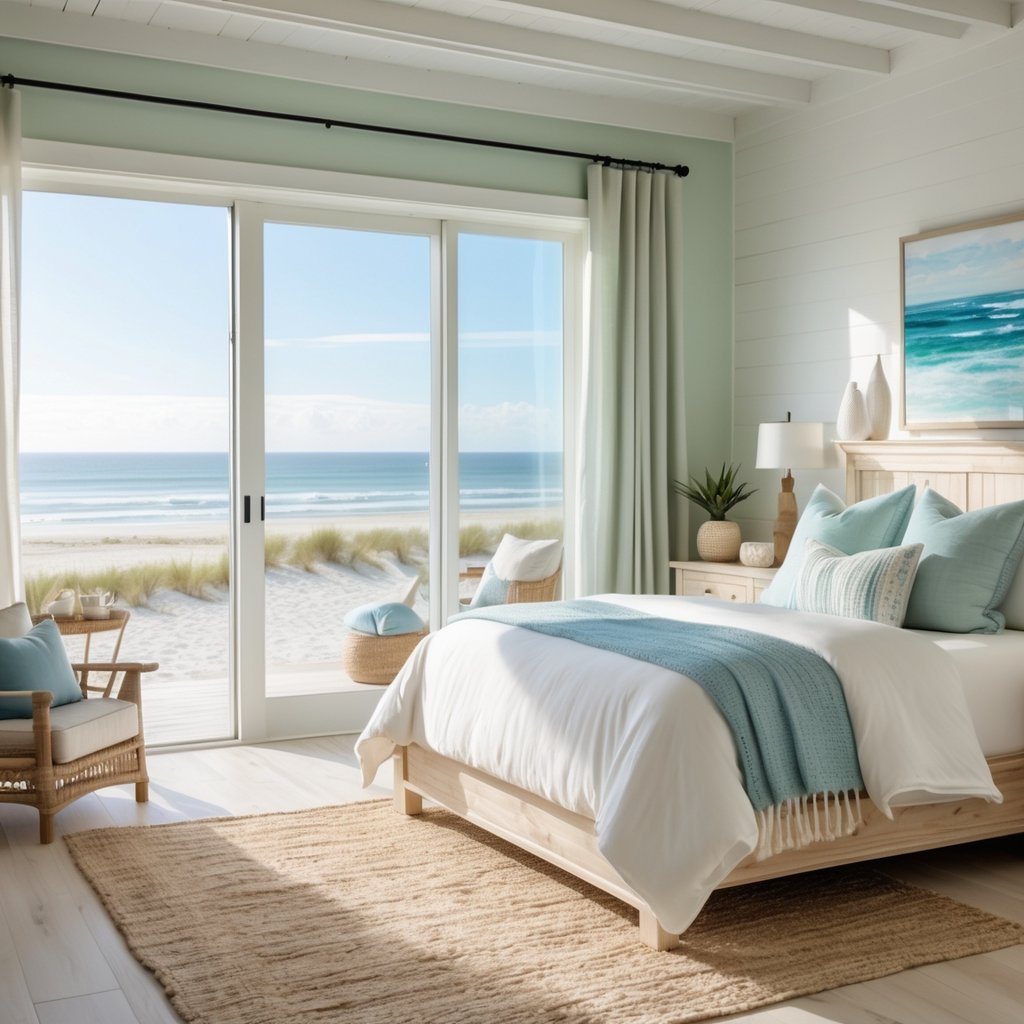
Textiles like linen curtains, cotton bedding, and woven rugs keep the space airy. Striped patterns or subtle nautical accents can bring in more coastal character without overwhelming the room.
Artwork featuring ocean views or seashell prints works well as wall decor. Small details, such as glass vases, driftwood pieces, or sea-inspired lamps, complete the look.
Large windows or light-filtering shades allow natural light to brighten the room. This keeps the space fresh and connected to the outdoors, even if the home is far from the coast.
7. Art-Filled Eclectic Style:
An art-filled eclectic bedroom blends different styles, colors, and textures to create a space that feels personal and layered. It often combines vintage finds, modern pieces, and bold artwork in one setting. This approach allows the room to showcase personality without following a strict design rule.
Artwork plays a central role in this style. Paintings, prints, or sculptures can be mixed together, even if they come from different eras or themes. The variety adds visual interest and makes the space feel curated rather than uniform.
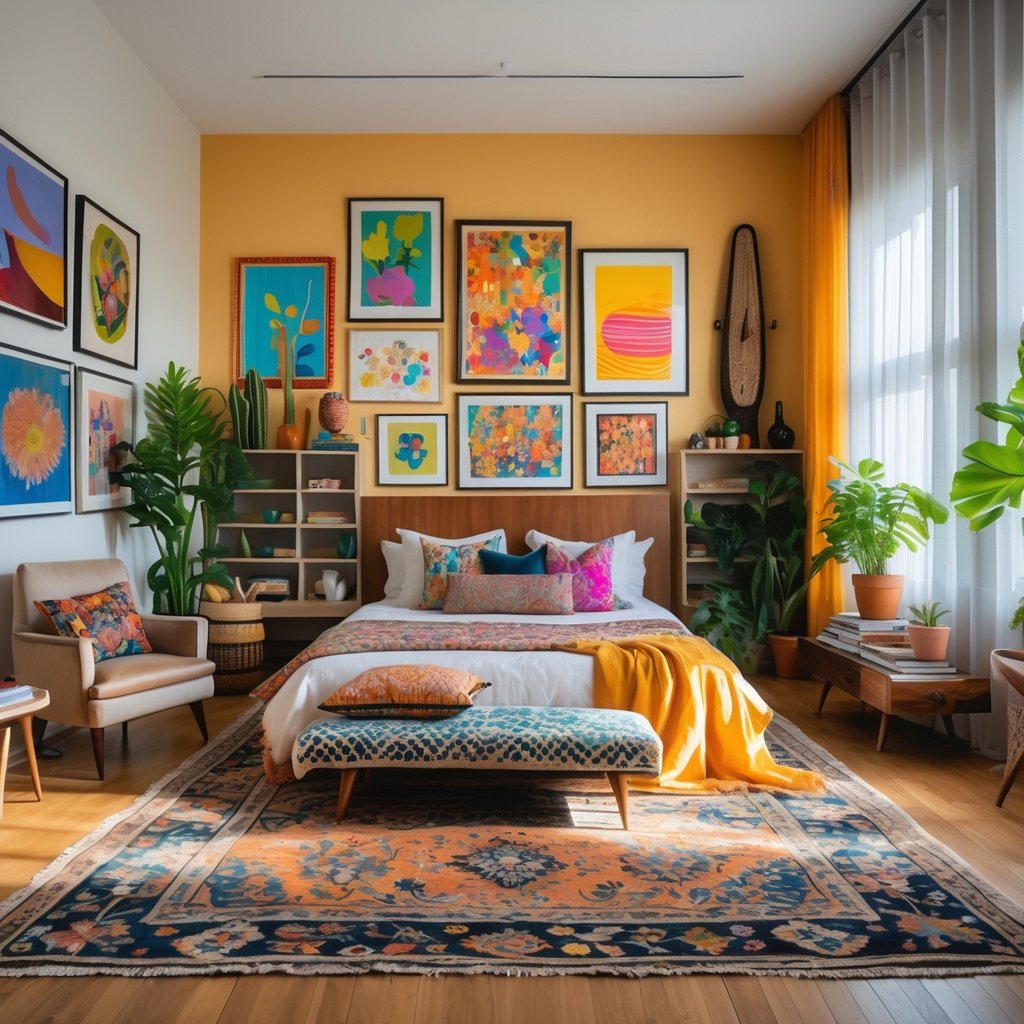
Furniture and decor often include a mix of materials. A sleek metal lamp may sit next to a carved wooden nightstand, while patterned textiles soften the room. These contrasts keep the space from feeling flat or predictable.
Color is used with intention but not always in a matching way. Bright tones may appear next to muted shades, creating balance through contrast. Layered rugs, textured bedding, and decorative pillows help tie the look together.
This style works well for people who enjoy collecting and displaying unique items. Each piece contributes to the character of the room, making it both functional and visually engaging.
8. Whimsical Bed Canopy Setup:
A whimsical canopy bed setup adds a playful yet calming touch to a bedroom. Light fabrics such as sheer curtains create a soft, airy look that feels inviting without overwhelming the space.
Small details make the design more personal. Hanging string lights or fairy lights along the canopy frame introduces a gentle glow that works well for evening relaxation.
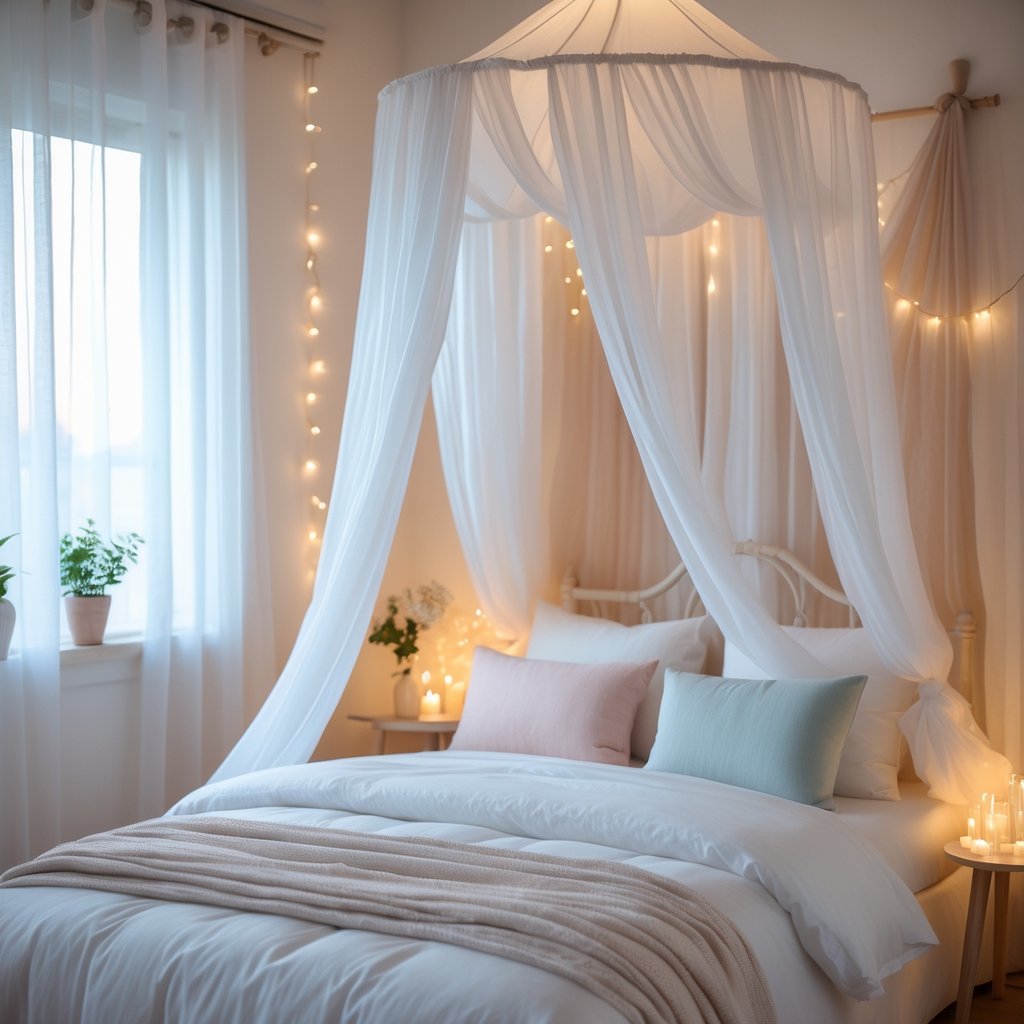
Decorative accents can enhance the effect. Dreamcatchers, macramé, or feathered ornaments placed on the corners of the canopy give the bed a bohemian feel. These elements pair nicely with earthy colors and layered textures.
The style works in both small and large rooms. A simple frame with minimal draping keeps the look uncluttered, while more fabric layers and decorative pieces create a cozier atmosphere.
This setup balances function and style. It provides a focal point for the bedroom while maintaining a light, comfortable environment.
9. Statement Arched Wall Niches:
Arched wall niches add a soft architectural detail that works well in bedrooms. Their curved shape creates a focal point without overwhelming the room. They can be simple and minimal or styled with decor for added interest.
Many people use niches to display artwork, vases, or small plants. This allows the wall to serve as both decoration and storage. In a bedroom, a niche can also hold lighting to create a warm and inviting effect.
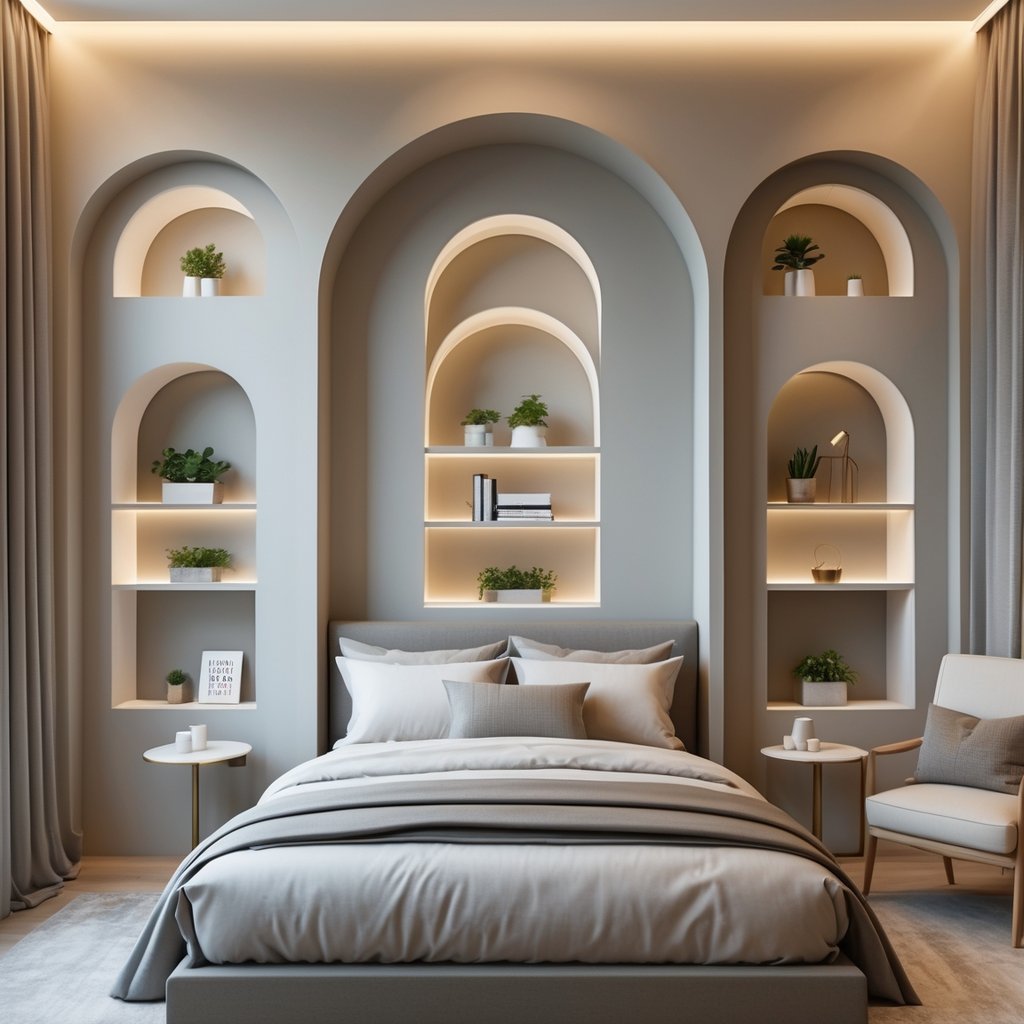
Placing an arched niche behind the bed can act as a natural accent wall. Neutral tones keep the look subtle, while painted or textured finishes make the niche stand out. The design can be adjusted to fit both modern and traditional interiors.
For smaller rooms, a niche can replace bulky shelving or nightstands. Built-in storage within the wall saves space and keeps the area uncluttered. This makes it a practical choice as well as an aesthetic one.
10. Color-Blocked Accent Walls:
Color-blocked accent walls use two or more solid colors to create a bold yet simple design. This approach adds visual interest without relying on patterns or heavy textures. It works well in both small and large bedrooms.
Many people choose geometric shapes like rectangles, diagonals, or half-and-half splits for a clean look. These designs can highlight architectural features or create a sense of structure in the room.
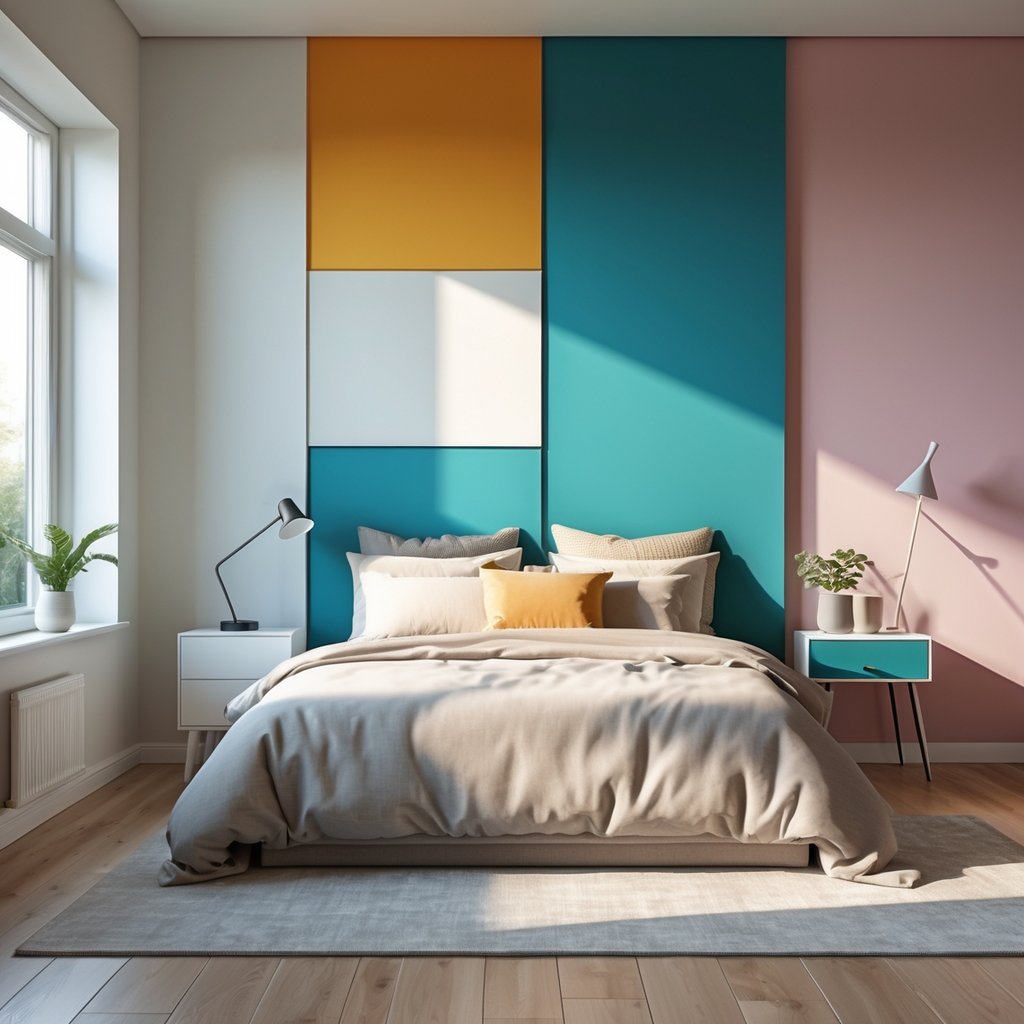
Color choices often depend on the mood they want to set. Soft neutrals paired with muted tones can feel calm, while brighter combinations like mustard, blue, or green bring more energy.
Paint is the most common way to achieve this look, but stencils and tape help keep lines sharp. Some also extend the design onto ceilings or furniture for a cohesive effect.
Color-blocking is flexible and budget-friendly, making it easy to update as styles change. It allows a bedroom to feel more personalized without overwhelming the space.
11. Disco Ball and Neon Lighting:
A disco ball adds movement and reflection to a bedroom. When light hits the mirrored surface, it creates small flashes across the walls and ceiling, giving the space a lively yet relaxed atmosphere.
Neon lighting pairs well with a disco ball because it provides steady color and glow. Strips of LED neon or wall-mounted neon signs can highlight certain areas of the room and balance the shifting reflections.
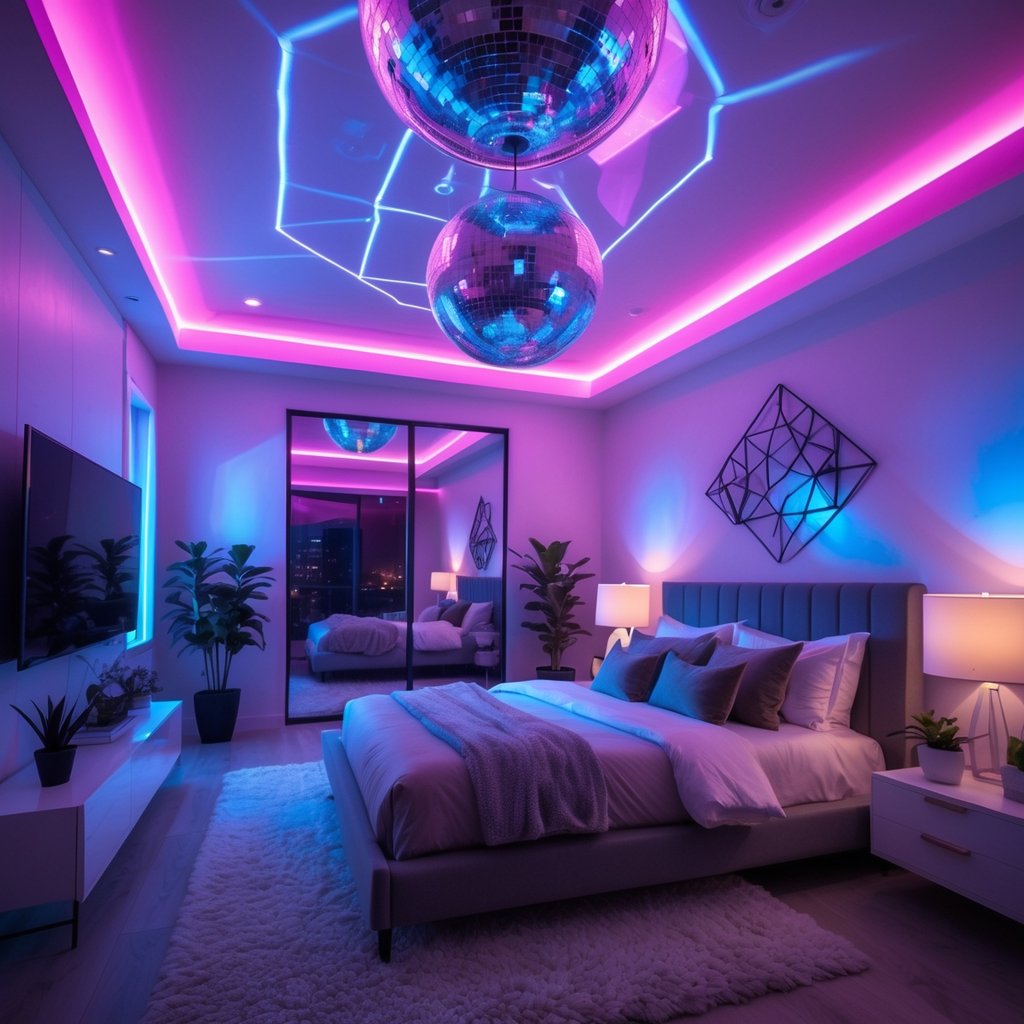
Together, these elements create a mix of retro and modern style. The disco ball brings a nostalgic touch, while neon lighting introduces a bold and customizable accent.
Placement matters for the best effect. Hanging the disco ball near a window or directing a spotlight onto it makes the reflections stand out. Positioning neon lights around the bed or desk gives the room a clear focal point.
This combination works in both small and large spaces. In a compact bedroom, one disco ball and a few neon strips can add character without overwhelming the room. In larger rooms, multiple neon accents and a bigger disco ball can create a more defined theme.
12. Collage Wall Gallery:
A collage wall gallery adds personality and visual interest to a bedroom. It allows someone to display photos, art prints, or postcards in a way that feels personal and creative.
Many people mix different frame sizes and colors to create variety. Others prefer a more uniform look with matching frames or a grid layout. Both approaches work well depending on the style of the room.
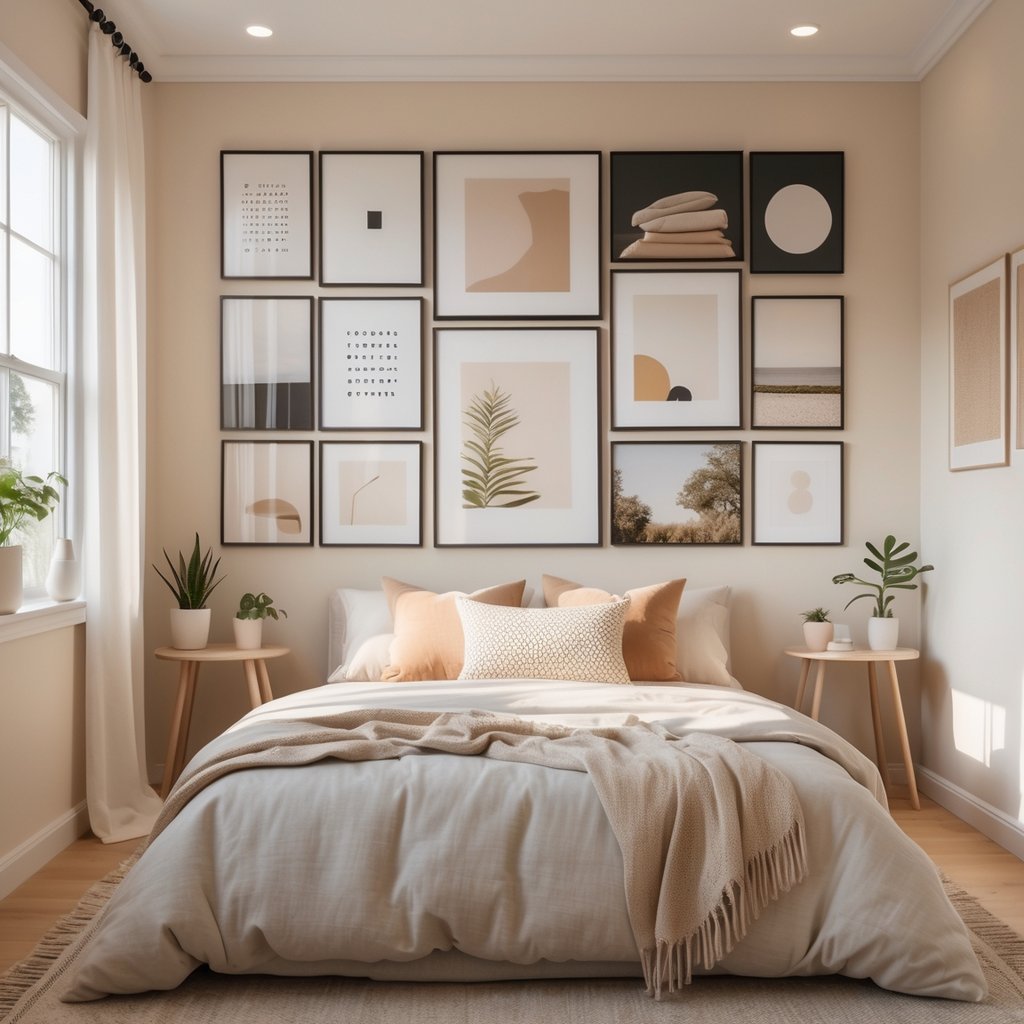
Photo collages can include travel memories, family pictures, or favorite artwork. Some choose to print aesthetic images or buy ready-made collage kits for an easier option.
Lighting can make a big difference. String lights or LED strips placed around the collage highlight the arrangement and add warmth to the space.
For a modern look, black and white photos or sepia tones create a clean and cohesive design. Those who want more energy often use bright colors, posters, or mixed textures.
This type of wall feature is easy to update. Swapping out images or rearranging the layout keeps the gallery fresh without requiring new furniture or major changes.
13. Textured Layered Bedding:
Layering bedding adds depth and comfort to a bedroom. By combining different fabrics, colors, and patterns, the bed looks more inviting and polished. This approach also allows flexibility to adjust layers for warmth or style throughout the year.
A common method includes starting with crisp sheets, followed by a quilt or lightweight blanket. A duvet or comforter can be placed on top for added warmth. Decorative throws and pillows finish the look, giving the bed a balanced mix of function and style.
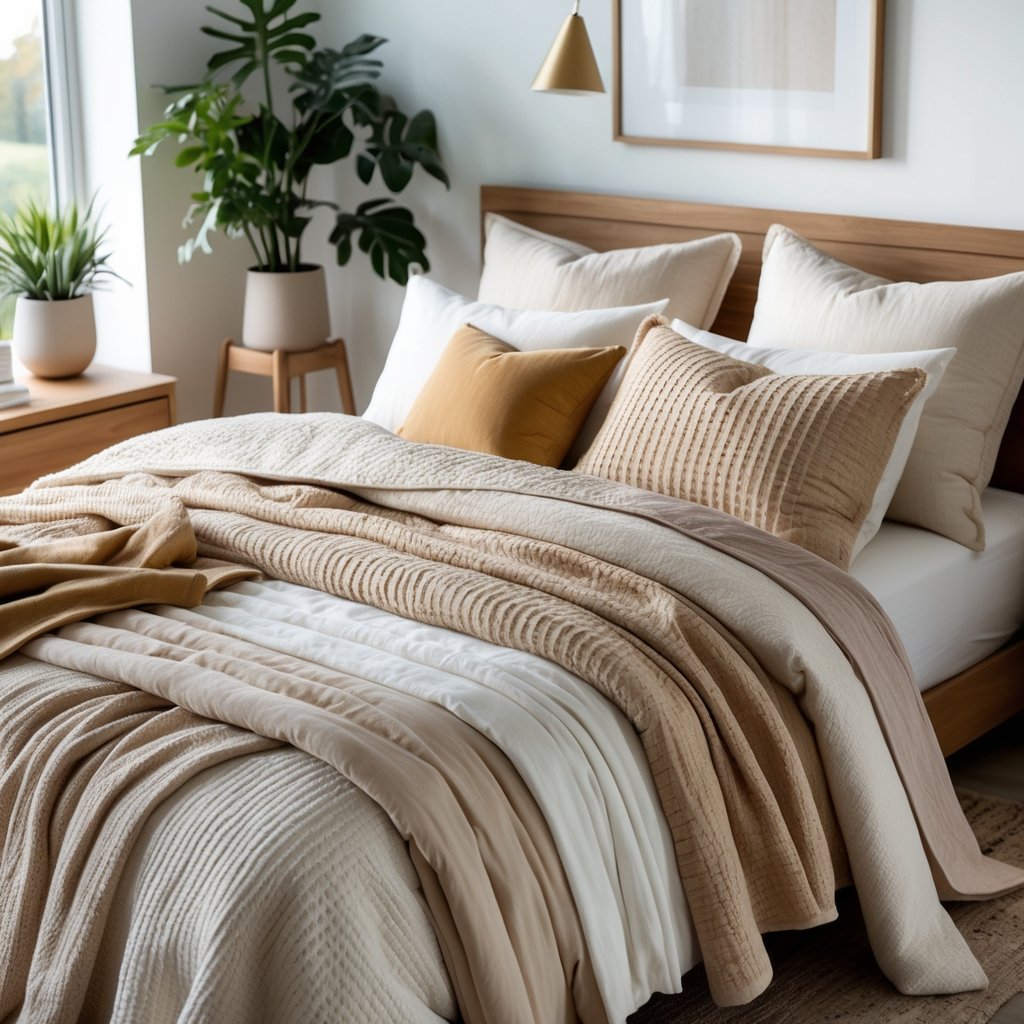
Texture plays an important role in layered bedding. Mixing smooth cotton with knits, linen, or velvet creates visual interest and a cozy feel. Using a variety of fabrics also prevents the bed from looking flat or one-dimensional.
Neutral tones often work well as a base, while accent colors can be introduced through pillows or throws. This makes it easy to refresh the look without replacing major pieces. The result is a bed that feels both comfortable and thoughtfully styled.
Fundamental Design Principles:
A well-designed bedroom depends on how colors, textures, and light interact to shape the space. Choices in these areas can make a room feel either calm and cohesive or cluttered and overwhelming.
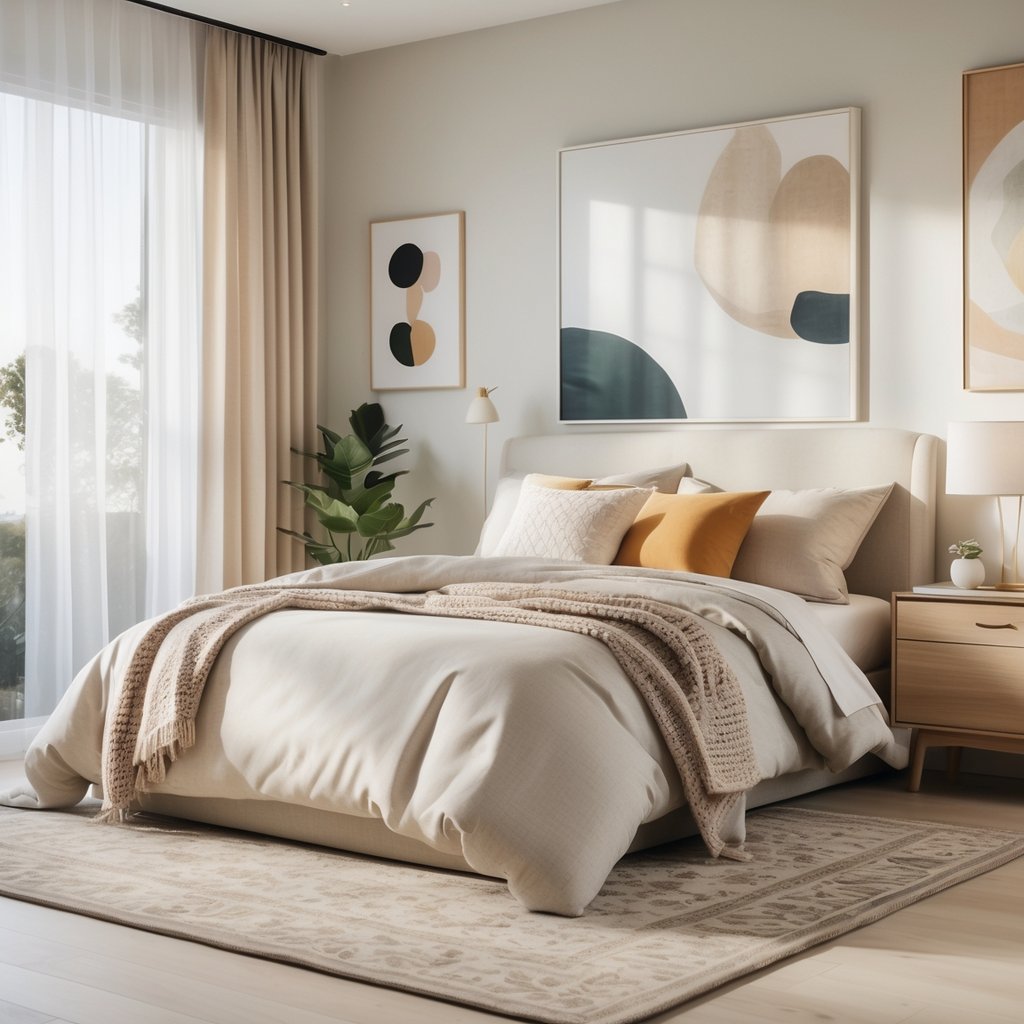
Balancing Color And Texture:
Color sets the mood of a bedroom, while texture adds depth and interest. Neutral tones like beige, gray, or soft white create a calm base, while accent colors such as muted greens or warm terracotta bring character without overwhelming the space.
Textures help prevent a flat look. A smooth wall pairs well with a woven rug, linen bedding, or a wooden nightstand. Mixing soft fabrics with harder surfaces creates balance and keeps the room from looking too uniform.
A simple way to apply this is by layering. For example:
- Walls: painted in a neutral tone
- Bedding: cotton sheets with a knit throw
- Furniture: wood or metal with visible grain or finish
This combination gives the room both comfort and structure. Heavier textures should be limited to a few pieces so they don’t dominate the design.
Maximizing Natural Light
Natural light makes a bedroom appear larger and more inviting. Large windows or glass doors work best, but smaller spaces can still benefit from thoughtful choices. Sheer curtains let in sunlight while maintaining privacy, while blinds with adjustable slats allow control over brightness.
Furniture placement also matters. Keeping bulky items away from windows prevents shadows and allows light to spread evenly. Mirrors placed opposite windows can reflect daylight deeper into the room.
For evening use, lighting should complement natural light rather than replace it. Warm-toned lamps and dimmable fixtures maintain a soft, relaxing atmosphere that feels consistent with daytime brightness. This balance avoids harsh transitions between day and night.
Personalizing Your Aesthetic Bedroom:
A bedroom feels more inviting when it reflects the person who lives in it. Small choices in decor and design can make the space feel unique while still keeping it stylish and cohesive.
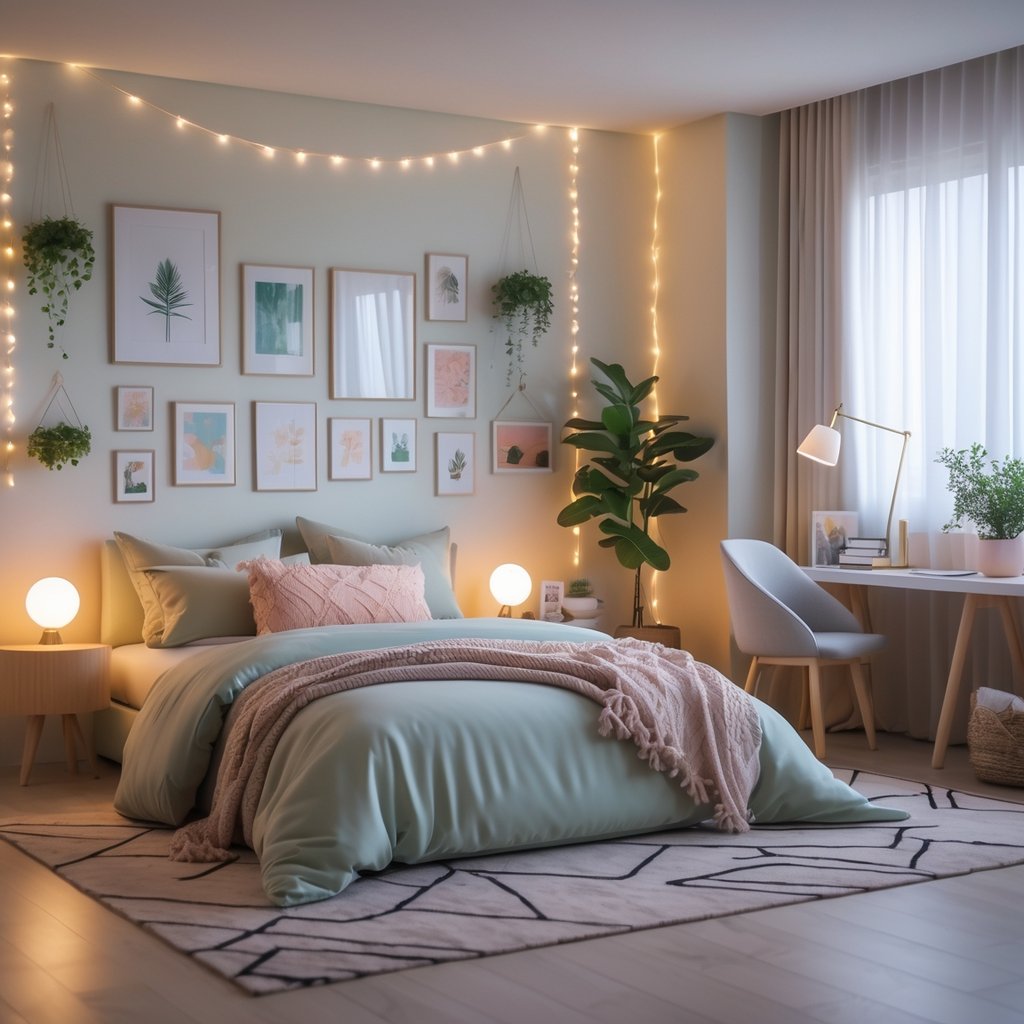
Incorporating Meaningful Decor:
Personal items can add depth to a room without making it cluttered. Framed photos, artwork, or souvenirs from trips give the space a story. A shelf with favorite books or records also adds personality while serving a functional role.
Using textiles is another simple way to personalize. A handmade quilt, patterned throw pillows, or a rug with cultural significance can stand out against neutral furniture. These pieces often become focal points that balance both comfort and design.
Lighting also plays a role. A desk lamp inherited from family or a lantern picked up while traveling can make the room feel personal. Instead of filling the space with generic items, choosing pieces with meaning ensures the room feels lived-in and authentic.
Blending Trends With Timeless Elements:
Trendy decor can make a bedroom feel current, but it works best when balanced with classic pieces. For example, pairing a modern LED strip light with a traditional wooden bed frame keeps the space stylish without feeling temporary.
Color choices also matter. Neutral walls provide a timeless backdrop, while accent colors—such as sage green, blush pink, or muted blue—can reflect popular aesthetics. This combination allows easy updates without repainting the entire room.
Furniture is another area to mix styles. A vintage dresser can sit alongside a sleek metal desk to create contrast. This approach avoids a one-note look and gives the room flexibility to evolve over time.
By blending lasting elements with trend-driven details, the bedroom stays adaptable while maintaining a cohesive design.
Frequently Asked Questions:
Design choices often depend on style, space, and personal taste. Specific details like color palettes, textures, and decor items help shape the look, while new trends continue to influence how people update their bedrooms.
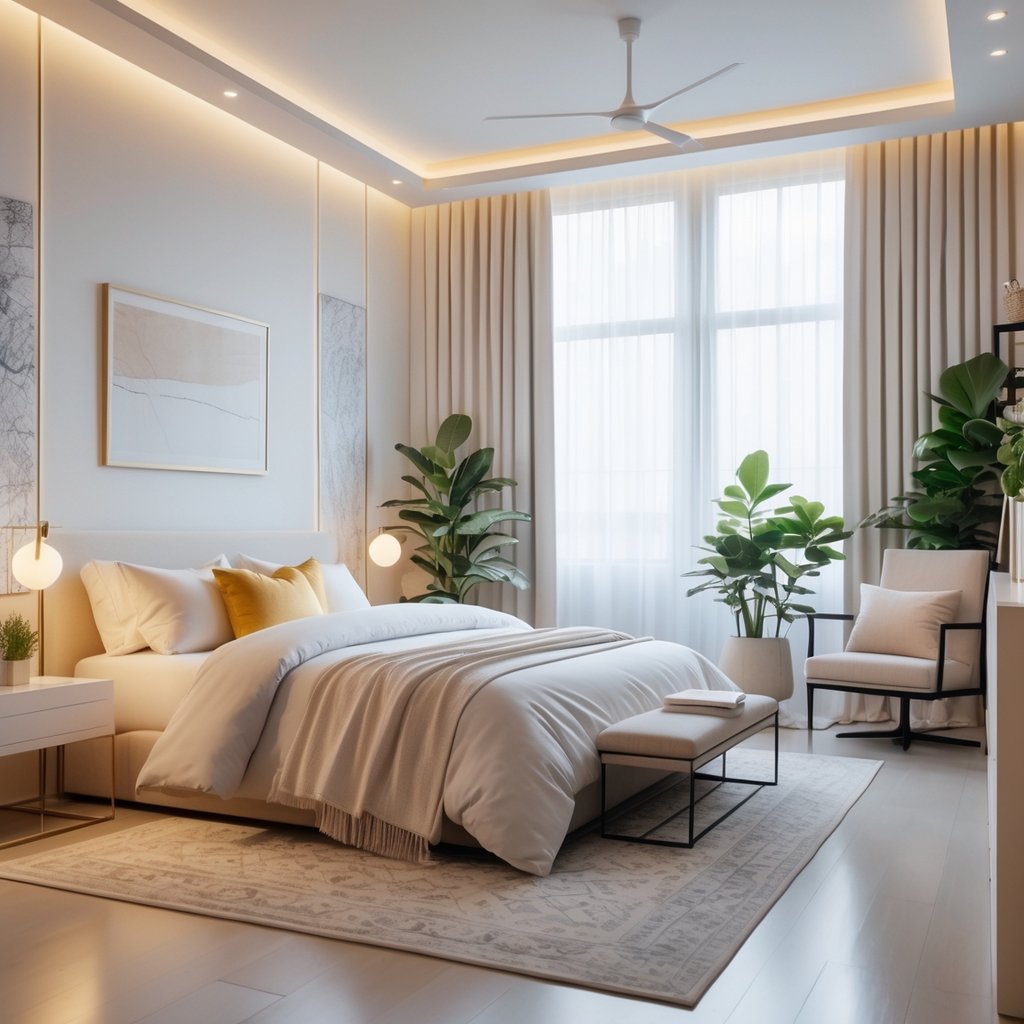
How Can I Incorporate A Clean Girl Aesthetic Into My Bedroom Decor?
She can use neutral tones such as white, beige, and soft gray to keep the space light and uncluttered. Simple bedding, glass or ceramic decor, and a few plants create a fresh and polished look. Clear surfaces and hidden storage help maintain a tidy, minimal feel.
What Are Some Aesthetic Bedroom Ideas Suitable For Small Rooms?
They can maximize space with multifunctional furniture like storage beds or wall-mounted shelves. Light colors on walls and bedding make the room feel larger. Mirrors also help reflect light and create the illusion of more space.
What Elements Define A Room As ‘Aesthetic’ In Interior Design?
An aesthetic room balances color, texture, and layout to create a cohesive look. Key elements include coordinated bedding, thoughtful lighting, and decor that reflects personal style. Small details, such as framed art or layered textiles, add character without overwhelming the space.
What Are The Emerging Bedroom Style Trends For 2025?
Warm wood tones, soft neutral palettes, and natural fabrics are becoming more popular. People are also mixing vintage pieces with modern furniture for a balanced look. Smart lighting and sustainable materials are expected to play a bigger role in bedroom design.
How Can I Create A Y2K Aesthetic In My Bedroom?
She can use bold colors like hot pink, purple, and metallic silver to capture the early 2000s vibe. Beaded curtains, lava lamps, and funky patterned bedding add playful energy. Posters, neon signs, and glossy finishes complete the nostalgic look.

